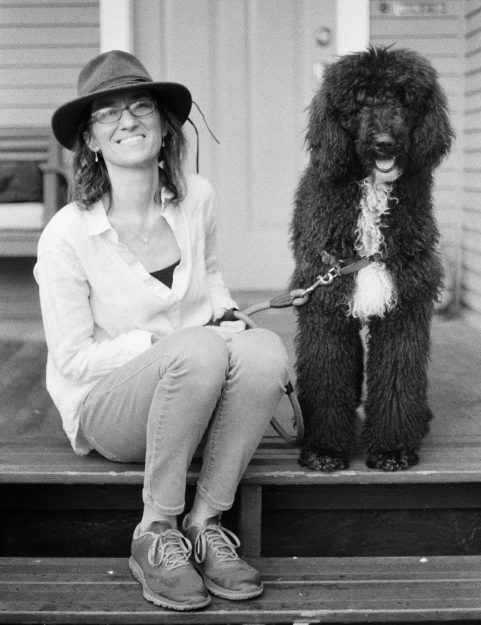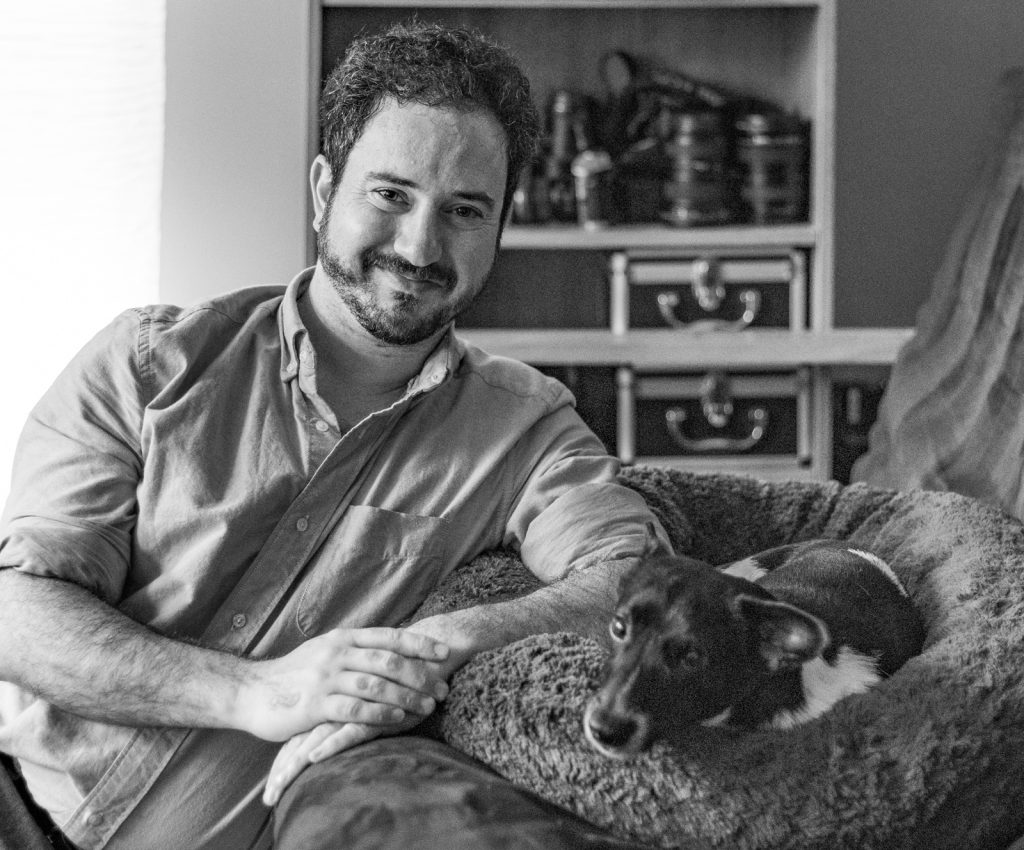A YouTube video for giving a relaxing dog massage starts off by drawing viewers’ attention to their breath. “If you’re not breathing calmly, your dog won’t be.” While working from home amid the pandemic, I adopted a dog, and so did countless others in New York City, as shelters and rescues struggled to keep up with an influx of applications. My dog, Calvin, was rescued from a hoarder at the age of 3. He was so timid and fearful that I started celebrating the simplest of acts, like walking from one side of the room to the other. If he sniffed a stranger’s leg, I was giddy. After months of resilience training, he began sitting beside me on the couch and resting his head on my right knee. (Left knee? No deal.) Meanwhile, I was languishing under lockdown and struggling to stick to a meditation routine, so this became my practice: Breathing, gently petting his head, removing my hand, giving him a treat, and repeat. It was not a real replacement for seated Zen meditation. I wasn’t letting thoughts go or moving beyond form and emptiness. I was just petting Calvin, but it was the best either of us could do.
This practice was not so unusual, I discovered after I spoke to a few dog-owning dharma teachers (at the suggestion of Tricycle contributing editor Sumi Loundon Kim). Paloma Cain, a Nashville-based Insight Meditation teacher, engages in a similar practice with her standard poodle, Fiona, who joined Cain’s family a little over a year before the pandemic arrived.
“The Satipatthana Sutta mentions practicing mindfulness of the breath both internally and externally, as in observing the breath of another,” she said. “If I’m feeling tense or uncomfortable, I like to watch Fiona rest and breathe. It’s a beautiful, informal practice of just watching her belly rise and fall and being present with the flow of her breath. And it is extraordinarily soothing to my nervous system.”
The connection has been helpful in this isolating time. Everyone that I spoke to said that they are closer not only to their dogs but also to the people they see in the neighborhood when they go for walks—though canine companionship often is enough.
“Human relationships are complex. We can’t count on each other to always be in the mood to comfort us. But dogs can be reliable in that way.” The same goes for when Fiona is in a more playful mood. “It’s hard not to wax clichéd about how ‘in the moment’ dogs are, but I find that present-moment awareness is very accessible through my connection with her because she’s so alive and present whenever she’s playing with a ball or pressing in for a snuggle.”

Playfulness is an important component of emotional well-being, says Pawan Bareja, a Spirit Rock-trained ritual minister and meditation teacher with a focus on trauma healing who lives in San Francisco with Amor, her 5-year-old Coton de Tulear.
“In working with trauma, we talk about building resilience, and two key characteristics of resiliency are connection and play. When you’re stressed out, you’re very task-oriented and don’t think about playfully connecting with people and building community. Dogs remind us of that. Even if I’m extremely busy, when Amor comes up to play, she breaks that stress response, makes me laugh, and then I move on to my work.”
Bareja said she’s witnessed similar responses from her students and clients when Amor interrupts a video call, like one time when she howled at a passing fire truck.
“We were talking about a very painful process . . . so when she started howling in the middle of my teaching, the whole class burst out laughing, and it brought some levity.”
Amor has also helped tip Bareja off about her client’s state of mind. “The way she would be with a client when they walk in versus when they leave, that told me a lot. If the client is settled after a session, she is extremely friendly. But if she’s withdrawn, then I know I should follow up with them.”
In a way, I’m Calvin’s trauma therapist. When he’s scared, he’s his own worst enemy. He’ll sprint away from whatever spooked him without any regard for the physical objects standing in his path. It’s a miracle he hasn’t broken a bone. Other times, he’ll freeze up or shut down for hours at a time. He’ll skip meals and ignore even his favorite treats. Once he refused to go to the bathroom for more than 24 hours. I don’t even know how that’s possible. It’s so clearly absurd, yet I catch myself doing the same thing, acting on some manufactured reality. Or I catch myself trying so hard to avoid something—say, an argument with my wife— that I make it happen. If only I were as patient with myself as I am with Calvin.
Cultivating such self-compassion is a central practice for the Buddhist teacher and author Bodhipaksa, a practice that he says inspired an article on his website titled “Meditating with Pets.” He suggested that practitioners reassure their disruptive pets rather than tune them out.
That’s what he does with Luna, his 2-year-old miniature pinscher mix, and 11-month-old Suki, a black Lab mix, both rescues from Arkansas.
“If the dogs are barking out of the window, for example, they are physiologically aroused,” he explained from his home in New Hampshire. “You can see their hackles standing up. They’re probably afraid and feeling threatened, and they need some reassurance”—a verbal cue (“You’re OK. Good girl.”) or physical contact. For Bodhipaksa, this is not a distraction but “an extension of what I do in my meditation practice. I teach a lot about self-compassion. When there’s something inside me that’s afraid, I offer it support and love. So it’s very natural for me, when the dogs are barking, to treat them the same as I would an internal distraction.”
“Dogs are not always convenient. But I think that deepens the compassion.”
Taking care of Suki and Luna has helped Bodhipaksa cultivate compassion as well. “I feel so much tenderness and love for them. Because they really are helpless. They’ve got big pointy teeth and look like ferocious hunters, but they can’t take care of themselves, not in our world full of traffic and strangers and things like that. I imagine that tenderness is having an effect on me, in the same way that having children softened me and made me kinder and more compassionate.”
Paloma Cain likewise has found that Fiona affected her compassion practice.
“I end my practice by naming specific people in my life that I have relationships with and allowing that connection and compassion to spread outward to all beings. Fiona is in the practice, too, and she has helped me connect with nonhuman beings in a new way.” Cain has long practiced visualizations to cultivate compassion, but they remained abstract contemplations. Cain said her relationship with Fiona has helped to ground the practice, in part because she has seen the complex reality of nonhuman beings, including their more challenging aspects. “Dogs are not always convenient. Fiona can just drive us crazy, and the first three months felt like I had a baby again. But I think that deepens the compassion, makes it more tangible. That darkness deepens the brightness.”
These difficult moments also can invite the practice of letting go and provide insight into “the unconditional love of another being,” says JD Doyle, co-guiding teacher of the meditation community Insight Santa Cruz. In January, Doyle (who uses the pronouns they/them) started sending applications to Bay Area rescues looking for a well-mannered, medium-sized dog, but despite having plenty of experience with dogs and a big fenced-in backyard, they struggled to navigate what has become an increasingly rigorous vetting process amid heightened demand. Eventually, they found their “pandemic puppy,” Flora, a 61-pound boxer-shepherd mix who had been surrendered to the rescue twice. Now 7 months old, Flora copes with separation anxiety by chewing through Doyle’s belongings.
“She decided my car was her favorite chew toy,” Doyle said. “She chewed through the gaskets around the windows. Then I sprayed the windows with an anti-chew spray, so she bit off the blinker switch.” Doyle is working with Flora on crate training and always leaves toys in the car and returns within 15 minutes. For the time being though, they said, “I’ve had to let go of my expectations for the life of the dog and accept what’s in front of me. She doesn’t know that her favorite toy is a car worth thousands of dollars. But that’s what insurance is for. My deductible was the cost of her chew toy.”
In a metta meditation, a practitioner typically begins with lovingkindness for oneself, then friends, then neutral people, then difficult people, and finally all beings. But for many, starting with oneself is a challenge. I’ve heard many meditation teachers say to start with a loved one and move to yourself, and if your relationships with loved ones are too complicated, you can try a pet. Now I understand why: it’s easy to wish your pet well.
I don’t know if I can cultivate an all-encompassing love. I want to think it’s possible, but I’ve yet to experience it firsthand. With Calvin, though, I’ve seen that growth can happen. As Calvin has seen what he’s capable of, he’s become more confident, more resilient, and less fearful, and the road ahead seems less daunting.
If a tiny traumatized dog can learn to trust and love and be himself, surely I can let go of my fears and fixations, too. At the very least, I want to set a good example—to show him, as he showed me, that we don’t need to be reincarnated to start a new life.
Thank you for subscribing to Tricycle! As a nonprofit, we depend on readers like you to keep Buddhist teachings and practices widely available.
